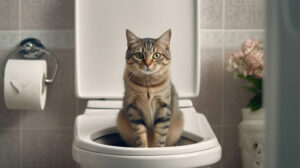Did you hear the one about cat poop clogging a toilet, resulting in thousands of gallons of sewage water in the home and a big insurance claim?
Lin Werkheiser, an insurance fraud investigator, has heard that one and many more like it.
“Our first question was, ‘How big was the cat?'” said Werkheiser, who led a Coalition Against Insurance Fraud webinar this week on the growing trend of fake or exaggerated water-damage claims across the country.
As director of special investigations for Command Investigations, based in Temecula, California, and Lake Mary, Florida, Werkheiser said a clogged toilet should rarely result in more than a few quarts of water overflowing in a property. But schemers continue to try and claim that such far-fetched scenarios have damaged entire structures, all in an effort to gain hefty insurance payouts, he said.
And Werkheiser said his team has noticed a disturbing trend in recent years: Many water-damage claims appear to be linked to home flippers, including real estate investors, hoping to trick property insurers into paying for renovations before a property is sold.
In some cases, insurance adjusters have been called to inspect claims on homes that were clearly in the midst of being remodeled or renovated. The property owner/policyholder had argued, though, that the polyethylene sheeting hung around the inside of the home was done to “dry out” or remediate the property after the massive water leak.
In reality, Werkheiser said, the sheeting was probably installed by a contractor for dust control during the the renovation work. Investigators’ moisture meters also found widely varying moisture levels throughout the home, on walls far from the supposed source of the leak and no signs of water intrusion on the ceiling above.
“All of that raises red flags,” he said.
Werkheiser’s examples are similar to claims highlighted by a few Florida engineers and insurance adjusters. They have said in 2022 that they have seen a rise in HO policy claims blaming cast-iron drainage pipes in older homes for breaks, clogs and leakages. But in many cases, the pipes last for decades and are not the source of the water. In another case, an engineer said someone smeared what appeared to be tomato sauce on a ceiling to simulate a leak.
In one California case Werkheiser related, the homeowners claimed that a 2-year-old child dropped something in the toilet then figured out how to flush the toilet just moments before the family left on vacation. The family said they returned home to find the place flooded, and filed a major claim.
It turns out, the family didn’t go to Disneyland as they said they had. And investigators scoffed at the idea that a toddler was smart enough to flush a toilet. “We had a lot of problems with that,” Werkheiser said.
He provided some other red flags for insurers to look for and how to handle them:
Scour property records and building permit records to determine if connections exist between claimants, buyers, public adjusters and contractors. In some instances, he noted, renovation firms are owned by relatives of homeowners or adjusters. Some Florida insurance companies have raised similar accusations through the years.

Verify living expenses. In other instances, insureds may claim additional living expenses are needed while a home is repaired. But in at least one case, the luxury AirB&B or rental property was owned by the brother-in-law of the claimant. In another example, the homeowner claimed living expenses – a lease on a bed and breakfast – but had never left the insured home.
Check similar records on commercial property. “We’re seeing these types of claims seeping into commercial property now,” Werkheiser said, referring to business interruption claims.
Beware of multiple claims on the same property in a short period of time, particularly within the first 90 days after a policy is written. Also, look for the same photographs submitted in different claims, or listings of the same contents.
Verify invoices. Investigators have seen what appear to be legitimate bed bug extermination invoices from a vendor, replete with logos, addresses and invoice numbers. But when they checked, the exterminator explained that the documents were fake: They looked spot-on but no record could be found of the work performed. “They were A.I.-generated,” Werkheiser said. “So, we take no documents at face value.”
Ask for the damaged equipment or photos of the water-damaged property and contents. Scammers are known to often claim that “all of that was thrown out.” If the parts are available, take them for examination and so they can’t be used again in a future claim. Another red flag: Insureds or public adjusters who stonewall or refuse to provide original photographs, which can be checked for metadata that show when the pictures were taken.
Scrutinize “Category 3” water claims. Water damage claims come in three types: Category 1 includes water leaks from clean, potable water sources. Category 2 is grey water, usually from bath or kitchen drain lines. Category 3 is nasty sewage water from toilet drain lines, which elevates the severity of the claim due to contamination. Werkheiser said insurers and investigators should always ask why the claimant or adjuster believes the water damage is considered a Cat 3 claim.
Topics Claims
Was this article valuable?
Here are more articles you may enjoy.



 Dog Bite Claims Soar in Frequency and Cost: Report
Dog Bite Claims Soar in Frequency and Cost: Report  NJ Wildfire Update: 50% Contained; High Spread Risk Today; Suspect in Custody
NJ Wildfire Update: 50% Contained; High Spread Risk Today; Suspect in Custody  Did Florida House ‘Sneak’ Attorney Fee Wording Into Phosphate Mine Bill?
Did Florida House ‘Sneak’ Attorney Fee Wording Into Phosphate Mine Bill?  World’s First Catastrophe-Bond ETF Falters in ‘Crazy’ Market
World’s First Catastrophe-Bond ETF Falters in ‘Crazy’ Market 


